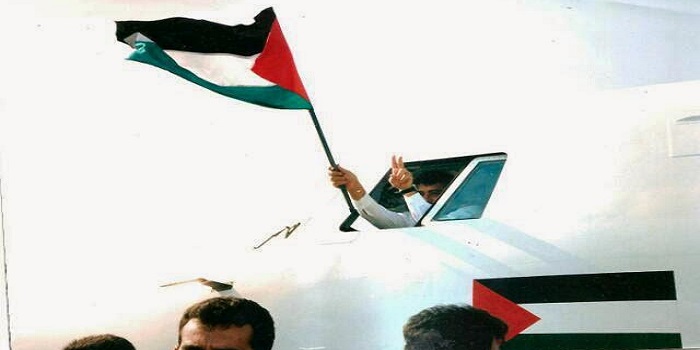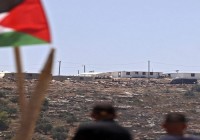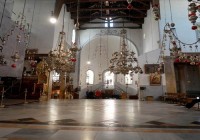The Palestinian Airlines: a Symbol of Sovereignty Raised by Two Planes

Captain Mansour in the first Palestinian landing at the the Gaza International Airport during its opening on 24/11/1998
Asma Marzouq – Palestine Economy Portal
Translated by Tamara Barakat
After 22 of its founding, the Palestinian Airlines Company is still able to preserve its entity and staff despite its small available capabilities and the fact that it is prohibited from flying in Palestinian sky and landing on its territories. It only enjoyed these rights for three years, from the end of 1998 and until the beginning of 2001, before the Israeli occupation forces destroyed the Gaza International Airport and completely prohibited any Palestinian air navigation activity.
Captain Mansour Ibrahim Saeed, the General Manager of the Palestinian Airlines, says that the devastating circumstances that the company suffers from prevented it from operating from a Palestinian airport and forced it to operate outside of Palestine instead, which placed extra burdens and expenses on the company. This impedes the development of projects and plans, and prevents the achievement of lucrative goals that would have been able to achieve had the company operated in and flown from and to Palestine.
He also adds that their primary goal is to preserve the Palestinian Airlines Company’s components so that it can keep on raising the Palestinian flag. He considers the sustainability of the company as a preservation of an important symbol of sovereignty.
The Palestinian Airlines owns two Fokker 50 airplanes, one of which is leased to Niger and another is currently undergoing periodic maintenance in order to be leased. The plane is leased with its Palestinian staff that consists of pilots, engineers, flight attendants, and dispatchers, for certain fees depending on the number of hours they operate monthly and an agreed on amount of money. The Fokker 50 that is leased to Niger is leased for a minimum of 80 hours each month, each for 1200 dollars. Consequently, its annual fees reach a million and 150 thousand dollars.
Regarding the company’s financial status, Captain Mansour explains that income of the two planes is sufficient to cover the maintenance, spare part, insurance, training, and employee expenses. He mentions that the decisions are made and policies are set by the company’s Board of Directors that is chaired by the Minister of Transportation, Sameeh Tbeileh. The Board consists of competent individuals and members of relevant ministries.
It is worth mentioning that the Palestinian Airlines’ employees are both military personnel and civilians who receive their salaries from the Government since they work in a public company. The company’s staff consists of 42 employees, 8 of whom are pilots, 10 are engineers, and 4 are flight attendants.
Captain Mansour explains that they are currently working on obtaining permissions to operate during the Umrah and Hajj seasons, for the Palestinian Airlines carry the Gazan pilgrims from the Cairo Airport to Saudi Arabia on Egyptian planes that are leased to the Palestinian Airlines based on a cooperation agreement.
Moreover, Captain Mansour is a pilot who graduated from the Pakistani Air Force Academy in 1979. He holds several military and civil aircraft qualifications, carries military, civil, and commercial aviation licenses, and is trained on flight simulators. He also has many certificates in aviation, and an experience of 40 years in this field. He was the first Palestinian pilot to land at the Gaza International Airport on the day of its opening on 24/11/1998, in an event that he described as a significant memory to him and the Palestinian people.
Moreover, Captain Mansour explains how the idea of a Palestinian airline started in the seventies, with a group of civil and military Palestinian pilots, who came from different countries and joined the Fateh movement in Syria. The first group was sent to Algeria to train and it was called the “Martyrs Squadron.” Other groups were sent to Morocco, Pakistan, and Libya. Cohorts of pilots and engineers graduated, with degrees in all specialties, and served in Arab, African, Asian, and South American countries.
After the Beirut War in 1982, the idea to make use of all of these growing numbers of competent pilots who were scattered in many countries started. An investment was made in the civil aviation sector, which was received by the Palestinian Investment Fund, and two D-8 planes and a Challenger jet were purchased. The late Yasser Arafat closely followed up on this issue and it was kept a secret due its sensitivity.
The two Palestinian airplanes flew for several years with their Palestinian pilots and staff to and from several airports in the world, but the Palestinian identity of the airline remained hidden for political and security reasons.
After the establishment of the Palestinian National Authority, the Palestinian Airlines was founded and was considered the official transporter for Palestine. Regular flights began to seven countries. The first regular flight took place on 10/10/1997 from the Port Said Airport, carrying Umrah pilgrims on board of the two Fokker 50 planes that were provided by the Dutch government, and later on using the Boeing 727 plane that was a gift from Prince Al-Waleed bin Talal.
Since the opening of the Gaza International Airport in 1998, the Palestinian aviation has been a member in many of the international aviation organizations, such as the International Civil Aviation Organization (ICAO), the Arab Air Carriers Organization (AACO), and the International Air Transport Association (IATA).
During the events of the Second Intifada, the Israeli warplanes destroyed the Gaza International Airport, and the Palestinian Airlines was forced to operate from the El Arish International Airport until it was closed. After that, the Palestinian Airlines’ planes were leased to several Arab and foreign companies.





